Cloud computing is no longer the future of technology, it is the present! From personal data like photos and videos to business information like email, documents and websites, Cloud is being extensively used to manage, store and share data. Businesses across the globe have embraced cloud computing for its ease of setting-up, affordability and scalability.
The biggest apprehension for businesses against moving to the Cloud has been around security vulnerabilities. Companies would stick to traditional on-premise set-up which is much more expensive, difficult to set-up and maintain for enhanced security measures. And, some would even go the extend of setting up isolated intranet with hard cable only connectivity. This is especially common amongst government organizations. Today, with Cloud being more prominently used across the board, security concerns are slowly being put to rest. Innovation in Cloud technology and significant security enhancements have been made Cloud safer and more accessible.
Cybersecurity experts suggests that Cloud today is as susceptible to vulnerabilities as any other platform. Cybersecurity in Cloud is also highly dependent on how well the service provider does with setting up their security measures. Not all cloud services offer end-to-end encryption, authentication and log audit. Therefore, selecting the right service provider is key. Poor configuration of the cloud can lead to exposure of sensitive data and open access to it. The other important consideration is whether it is a single-tenant or multi-tenant Cloud environment. With shared space, it is important to ensure that data is isolated from one another and custom configuration are in place to avoid compromises. Cloud users must upgrade to any available updates to install security patches that have been identified and fixed by the service provider. Failure to upgrade would mean that the data is still vulnerable to identified threats.
Despite known susceptibilities, many security pandits suggest that the future of cybersecurity is in the Cloud. Cloud is poised to leverage big data and analytics to lead cybersecurity. The sheer number of users, data stored and shared, allow Cloud technology to identify trends and patterns. Cybersecurity experts see Cloud using this intelligence to not only enhance security measures but also prevent attacks from happening. Cloud service providers must come together to analyse user pattern and identify normal and abnormal activities to build a repository of global threat monitoring intelligence. Once any abnormal activity is defined that could jeopardize the security, Cloud service provider can take preventative measures. The other major way Cloud leads cybersecurity is through releasing fixes and patches on the go. Once identifying any vulnerabilities, service providers are generally quick to release a patch to safeguard users from any upcoming threats.

